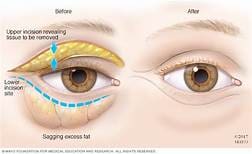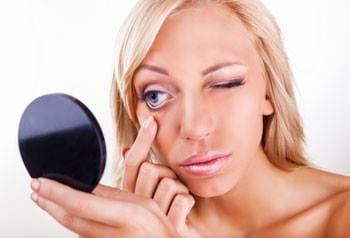How to get rid of bags under your eyes
You’ll be glad to know that there are a number of steps you can take to minimize the appearance of eye bags.
First, let’s unpack some of the mysteries and myths surrounding under-eye bags.
What are bags under the eyes?
Bags under the eyes occur when weakened and sagging skin relaxes, forming a pouch. The fat pads located under the eyes slip down to fill the space.
Excess fluid in the body can also pool there, making the lower lids look even puffier and more swollen. Shadows and discolored skin under the eyes cause eye bags to look more prominent.
Unattractive, under-eye bags are primarily a cosmetic issue and usually are harmless. But sometimes they can be a sign of an underlying medical condition.
Most bags under the eyes are more noticeable in the morning, when fluid has had all night to settle in.
What causes bags under the eyes?
The most common cause of bags under the eyes is aging. As we get older, we experience a loss of fat padding and collagen, the major component of connective tissues in skin, muscles and other body parts.
Lower collagen levels cause the skin and underlying muscles all over the body to lose elasticity and tone. This sagging is especially noticeable around the eyes because the skin there is very thin.
Other factors that contribute to the development of bags under the eyes include fluid retention, chronic medical conditions like thyroid disease, infections, allergies, stress, eye fatigue, smoking, lack of sleep and inherited facial features.
If the swelling becomes severe, painful, itchy, red or persistent, see one of our eye doctors for a medical diagnosis.

Remedies for bags under eyes
Identifying the underlying cause of bags under the eyes is the first step in choosing a remedy.
For example, if eye bags are a result of aging or run in your family, a cosmetic solution like plastic surgery may be the best option for getting rid of them.
Know up front that cosmetic eye surgery done solely to improve appearance will not be covered by medical insurance.
When bags under the eyes are the result of environmental or underlying health issues, there are some simple home remedies and lifestyle changes that may help to lessen their appearance. These include:
- Get plenty of sleep (average 8 hours daily).
- Sleep with your head elevated a few inches to keep fluid from pooling around your eyes.
- Avoid fluids before bedtime and salt throughout the day.
- Use a damp, cool washcloth as a compress on your eyes, preferably while sitting upright. Alternatively, cucumber slices or cold, damp tea bags can be used to help bring down swelling.
- Keep your allergy symptoms under control by avoiding triggers and taking prescription or over-the-counter allergy medications.
- Use cosmetic concealers to cover up dark under-eye shadows.
One popular home remedy for reducing bags under the eyes is the use of hemorrhoid creams. (Yes, really.)
Hemorrhoid creams contain phenylephrine, which constricts blood vessels and can temporarily tighten the skin under the eyes, making eye bags less noticeable. Be careful not to get the cream in your eyes as it could irritate them.
If you’re a smoker, make every effort to quit. Avoiding smoking not only is good for your general health and eyesight — it also will slow down collagen loss that thins the skin. And if you choose to have cosmetic surgery to remove bags under your eyes, you’ll heal quicker if you don’t smoke.
There are also wrinkle treatments and skin therapies designed to tighten under-eye skin and reduce puffiness. The list includes chemical peels, laser resurfacing and injectable dermal fillers.
The benefits, side effects, and risks associated with these options or surgery should be discussed with your optometrist, and / or plastic surgeon.
Surgery for bags under eyes
If you’ve tried some or all of the remedies listed above to eliminate the bags under your eyes and aren’t satisfied with the results, you may want to consider a more permanent solution.
Cosmetic eyelid surgery, also known as blepharoplasty, can smooth out and tighten the skin under the lower eyelids. Blepharoplasty also can be used to treat puffy or drooping eyelids.
Lower lid blepharoplasty for bags under the eyes is typically done as an outpatient procedure under local anesthesia plus sedation. (In some cases, general anesthesia may be used.)
Prior to surgery, the surgeon will mark up the under-eye area to indicate where he or she will make the incisions. Typically, the incisions are made inside the lower eyelid or under the eyelashes.
Once the incisions are made, the surgeon removes the excess fat and extra skin before suturing the incisions closed with tiny dissolvable stitches. The desired result is smoother, “lifted” skin.
It’s important to follow your surgeon’s post-surgical instructions to maximize healing. Cold compresses applied regularly for about 48 hours will help reduce swelling and discomfort. Prescription ointments and eye drops should be used as directed by your surgeon to promote healing and help prevent infection.
Expect some swelling, bruising, and dry eyes in the days immediately following surgery. If you go outside, protect your healing skin and eyes with darkly tinted sunglasses. Avoid strenuous physical exercise for at least a week following surgery.
Most people find that swelling and bruising decreases significantly in about 10 to 14 days to the point that they feel comfortable going out in public again. Always call your eye doctor if you have any unusual symptoms or pain that may indicate post-surgery problems.
All surgeries, no matter how minor, have risks attached. Potential risks associated with blepharoplasty include:
- bleeding
- bruising
- soreness
- infection
- numbness to the touch
- skin discoloration
- cysts along the incision lines
- poor healing, especially among smokers
- drooping upper eyelid
Complete recovery from eyelid surgery takes six weeks or more. Report any symptoms or questions you may have to your surgeon at your follow-up visits.







